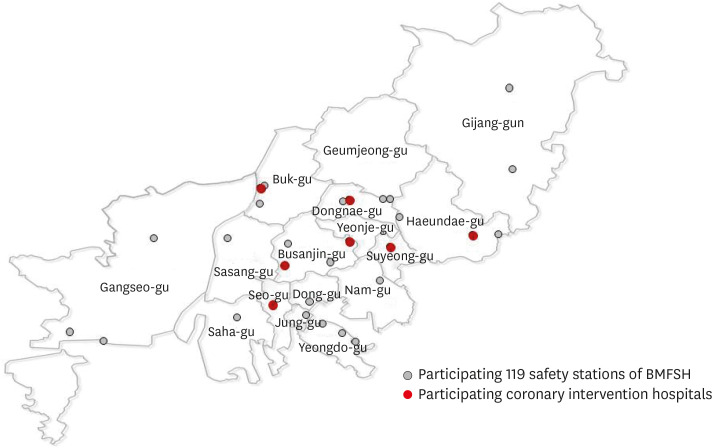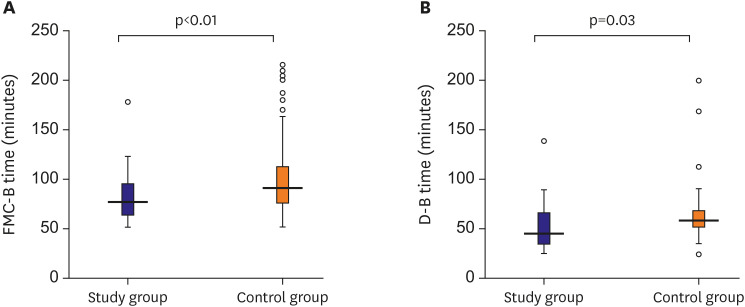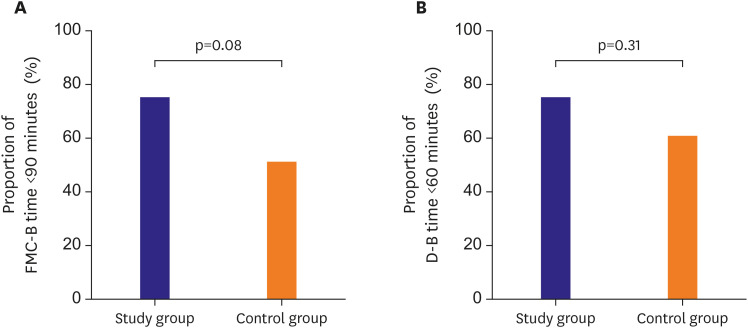Korean Circ J.
2020 Aug;50(8):709-719. 10.4070/kcj.2019.0337.
Community-Based Pre-HospitalElectrocardiogram TransmissionProgram for Reducing Systemic TimeDelay in Acute ST-Segment ElevationMyocardial Infarction
- Affiliations
-
- 1Department of Cardiology, Dong-A University Hospital, Dong-A University College of Medicine, Busan, Korea
- 2Cardiovascular Center, Busan Regional Cardio-cerebrovascular Center, Dong-A University Hospital, Busan, Korea
- 3Department of Inje University Baek Hospital, Inje University College of Medicine, Busan, Korea
- 4Department of Cardiology, Inje University Haeundae Baek Hospital, Inje University College of Medicine, Busan, Korea
- 5Department of Cardiology, Dong-Eui Medical Center, Busan, Korea
- 6Department of Cardiology, Dong Rae Bong Seng Hospital, Busan, Korea
- 7Department of Cardiology, Gupo Sungshim Hospital, Busan, Korea
- 8Department of Cardiology, BHS Hanseo Hospital, Busan, Korea
- 9Metropolitan City Fire and Safety Headquarters, Busan, Korea
- KMID: 2505125
- DOI: http://doi.org/10.4070/kcj.2019.0337
Abstract
- Background and Objectives
In acute ST-segment elevation myocardial infarction (STEMI),on-site transmission of electrocardiogram (ECG) has been shown to reduce systemic timedelay to reperfusion and improve outcomes. However, it has not been adopted in communitybasedemergency transport system in Korea.
Methods
Busan Regional Cardio-cerebrovascular Center and Busan Metropolitan City Fireand Safety Headquarters (BMFSH) jointly developed and conducted a pre-hospital ECGtransmission program. Seven tertiary hospitals and 22 safety stations of BMFSH participated.Systemic time delay to reperfusion of STEMI patients in the program was compared with thatof 95 patients transported by 119 emergency medical system (EMS) before the program wasimplemented.
Results
During the study period, 289 ECG transmissions were made by 119 EMS personnel,executed within 5 minutes in 88.1% of cases. Of these, 42 ECGs were interpreted as STsegmentelevation. Final diagnosis of STEMI was made in 20 patients who underwent primarypercutaneous coronary intervention. With the program, systemic time delay to reperfusion wassignificantly reduced (median [interquartile range; IQR], 76.0 [62.2–98.7] vs. 90.0 [75.0–112.0],p<0.01). Significant reduction of door-to-balloon time was also observed (median [IQR], 45.0[34.0–69.5] vs. 58.0 [51.0–68.0], p=0.03). The proportion of patients with systemic time delayshorter than 90 minutes rose (51.6% vs. 75.0%, p=0.08) with pre-hospital ECG transmission.
Conclusions
We developed and implemented a community-based pre-hospital ECG transmission program for expeditious triage of STEMI patients. Significant reductions ofsystemic time delay and door-to-balloon time were observed. The expanded use of prehospitalECG transmission should be encouraged to realize the full potential of this program.
Figure
Cited by 1 articles
-
A Simple Protocol to Save Time Delay for Patients with ST-Elevation Myocardial Infarction by Using Pre-hospital Electrocardiogram Transmission Program
Jung-Joon Cha, Soon Jun Hong
Korean Circ J. 2020;50(8):720-722. doi: 10.4070/kcj.2020.0218.
Reference
-
1. Denktas AE, Anderson HV, McCarthy J, Smalling RW. Total ischemic time: the correct focus of attention for optimal ST-segment elevation myocardial infarction care. JACC Cardiovasc Interv. 2011; 4:599–604. PMID: 21700244.2. Francone M, Bucciarelli-Ducci C, Carbone I, et al. Impact of primary coronary angioplasty delay on myocardial salvage, infarct size, and microvascular damage in patients with ST-segment elevation myocardial infarction: insight from cardiovascular magnetic resonance. J Am Coll Cardiol. 2009; 54:2145–2153. PMID: 19942086.3. De Luca G, Suryapranata H, Ottervanger JP, Antman EM. Time delay to treatment and mortality in primary angioplasty for acute myocardial infarction: every minute of delay counts. Circulation. 2004; 109:1223–1225. PMID: 15007008.4. Bradley EH, Nallamothu BK, Stern AF, et al. The door-to-balloon alliance for quality: who joins national collaborative efforts and why? Jt Comm J Qual Patient Saf. 2009; 35:93–99. PMID: 19241729.
Article5. Kim HK, Jeong MH, Ahn Y, et al. Relationship between time to treatment and mortality among patients undergoing primary percutaneous coronary intervention according to Korea Acute Myocardial Infarction Registry. J Cardiol. 2017; 69:377–382. PMID: 27720323.
Article6. McNamara RL, Wang Y, Herrin J, et al. Effect of door-to-balloon time on mortality in patients with ST-segment elevation myocardial infarction. J Am Coll Cardiol. 2006; 47:2180–2186. PMID: 16750682.
Article7. Berger PB, Ellis SG, Holmes DR Jr, et al. Relationship between delay in performing direct coronary angioplasty and early clinical outcome in patients with acute myocardial infarction: results from the global use of strategies to open occluded arteries in Acute Coronary Syndromes (GUSTO-IIb) trial. Circulation. 1999; 100:14–20. PMID: 10393675.8. Brodie BR, Stone GW, Morice MC, et al. Importance of time to reperfusion on outcomes with primary coronary angioplasty for acute myocardial infarction (results from the Stent Primary Angioplasty in Myocardial Infarction Trial). Am J Cardiol. 2001; 88:1085–1090. PMID: 11703949.
Article9. Zijlstra F, Patel A, Jones M, et al. Clinical characteristics and outcome of patients with early (<2 h), intermediate (2-4 h) and late (>4 h) presentation treated by primary coronary angioplasty or thrombolytic therapy for acute myocardial infarction. Eur Heart J. 2002; 23:550–557. PMID: 11922645.10. Menees DS, Peterson ED, Wang Y, et al. Door-to-balloon time and mortality among patients undergoing primary PCI. N Engl J Med. 2013; 369:901–909. PMID: 24004117.
Article11. Lee WC, Fang HY, Chen HC, et al. Effect of improved door-to-balloon time on clinical outcomes in patients with ST segment elevation myocardial infarction. Int J Cardiol. 2017; 240:66–71. PMID: 28390745.
Article12. Terkelsen CJ, Sørensen JT, Maeng M, et al. System delay and mortality among patients with STEMI treated with primary percutaneous coronary intervention. JAMA. 2010; 304:763–771. PMID: 20716739.
Article13. O'Gara PT, Kushner FG, Ascheim DD, et al. 2013 ACCF/AHA guideline for the management of ST-elevation myocardial infarction: a report of the American College of Cardiology Foundation/American Heart Association Task Force on Practice Guidelines. Circulation. 2013; 127:e362–425. PMID: 23247304.14. Ibanez B, James S, Agewall S, et al. 2017 ESC Guidelines for the management of acute myocardial infarction in patients presenting with ST-segment elevation: The Task Force for the management of acute myocardial infarction in patients presenting with ST-segment elevation of the European Society of Cardiology (ESC). Eur Heart J. 2018; 39:119–177. PMID: 28886621.15. Pedersen SH, Galatius S, Hansen PR, et al. Field triage reduces treatment delay and improves long-term clinical outcome in patients with acute ST-segment elevation myocardial infarction treated with primary percutaneous coronary intervention. J Am Coll Cardiol. 2009; 54:2296–2302. PMID: 19958965.
Article16. Le May MR, Wells GA, So DY, et al. Reduction in mortality as a result of direct transport from the field to a receiving center for primary percutaneous coronary intervention. J Am Coll Cardiol. 2012; 60:1223–1230. PMID: 23017532.
Article17. Ducas RA, Labos C, Allen D, et al. Association of pre-hospital ECG administration with clinical outcomes in ST-segment myocardial infarction: a systematic review and meta-analysis. Can J Cardiol. 2016; 32:1531–1541. PMID: 27707525.
Article18. Le May MR, So DY, Dionne R, et al. A citywide protocol for primary PCI in ST-segment elevation myocardial infarction. N Engl J Med. 2008; 358:231–240. PMID: 18199862.
Article19. Brunetti ND, Di Pietro G, Aquilino A, et al. Pre-hospital electrocardiogram triage with tele-cardiology support is associated with shorter time-to-balloon and higher rates of timely reperfusion even in rural areas: data from the Bari-Barletta/Andria/Trani public emergency medical service 118 registry on primary angioplasty in ST-elevation myocardial infarction. Eur Heart J Acute Cardiovasc Care. 2014; 3:204–213. PMID: 24604713.20. Kawakami S, Tahara Y, Noguchi T, et al. Time to reperfusion in ST-segment elevation myocardial infarction patients with vs. without pre-hospital mobile telemedicine 12-lead electrocardiogram transmission. Circ J. 2016; 80:1624–1633. PMID: 27250917.
Article21. Ong ME, Wong AS, Seet CM, et al. Nationwide improvement of door-to-balloon times in patients with acute ST-segment elevation myocardial infarction requiring primary percutaneous coronary intervention with out-of-hospital 12-lead ECG recording and transmission. Ann Emerg Med. 2013; 61:339–347. PMID: 23021348.
Article22. Kahlon TS, Barn K, Akram MM, et al. Impact of pre-hospital electrocardiograms on time to treatment and one year outcome in a rural regional ST-segment elevation myocardial infarction network. Catheter Cardiovasc Interv. 2017; 89:245–251. PMID: 27142567.
Article23. Diercks DB, Kontos MC, Chen AY, et al. Utilization and impact of pre-hospital electrocardiograms for patients with acute ST-segment elevation myocardial infarction: data from the NCDR (National Cardiovascular Data Registry) ACTION (Acute Coronary Treatment and Intervention Outcomes Network) Registry. J Am Coll Cardiol. 2009; 53:161–166. PMID: 19130984.24. Park YH, Kang GH, Song BG, et al. Factors related to prehospital time delay in acute ST-segment elevation myocardial infarction. J Korean Med Sci. 2012; 27:864–869. PMID: 22876051.
Article25. Thygesen K, Alpert JS, Jaffe AS, et al. Third universal definition of myocardial infarction. J Am Coll Cardiol. 2012; 60:1581–1598. PMID: 22958960.
Article26. Sejersten M, Sillesen M, Hansen PR, et al. Effect on treatment delay of prehospital teletransmission of 12-lead electrocardiogram to a cardiologist for immediate triage and direct referral of patients with ST-segment elevation acute myocardial infarction to primary percutaneous coronary intervention. Am J Cardiol. 2008; 101:941–946. PMID: 18359312.
Article27. Ong ME, Wong AS, Seet CM, et al. Nationwide improvement of door-to-balloon times in patients with acute ST-segment elevation myocardial infarction requiring primary percutaneous coronary intervention with out-of-hospital 12-lead ECG recording and transmission. Ann Emerg Med. 2013; 61:339–347. PMID: 23021348.
Article
- Full Text Links
- Actions
-
Cited
- CITED
-
- Close
- Share
- Similar articles
-
- ST segment
- Precordial ST-Segment Elevation in Acute Right Ventricular Myocardial Infarction
- The Prognostic Significance of Maximal Precordial ST-Segment Depression in Patients with Acute Inferior Myocardial Infarction
- Reciprocal ST-segment depression in acute inferior myocardial infarction : Possible indicator of concomitant left anterior descending coronary artery stenosis
- ST Segment Depression in Lateral Leads in Inferior Wall Acute Myocardial Infarction




